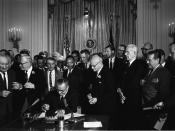INTRODUCTION
Scan the newspapers, listen to the evening news, peruse a periodical, survey the literature, talk to a friend, and you too will find example after example of organizations and individuals faced with the costly effects of discrimination and harassment in the workplace. The basic federal law against job discrimination is Title VII of the Civil Rights Act of 1964. This law makes job discrimination illegal.
Employers cannot use race, skin color, age, gender, religious belief, or national origin as their basis for hiring; nor can these be used as the basis for promotions, dismissals, pay raises, benefits, assignments, leaves of absence, or any other employment relationship-- from pre-hiring interviews to post-employment references. The Civil Rights Act of 1992 broadened the law. If workers can prove that a particular employment practice tends to exclude women or minorities, for example, then the employer must show that the practice is job-related or consistent with business necessity.
During the late summer and early fall of 2003, I was privy to information that lead me to believe my potential boss may have been passed over due to his weight and the fact he was Native American. This person was said to have been asked why he was so over weight and how he felt that may hinder his ability to do his job. He never did get the job and perhaps we'll never know the real reasons why. The hiring process has since seen its fair share of changes and alterations. Understanding diverse backgrounds was the key to getting the Director we needed.
The underlying expectation of the diversity training process is to provide an avenue of learning and create a level of awareness that would eliminate discrimination and harassment in the workplace. At first, diversity training seemed to be the needed answer...


